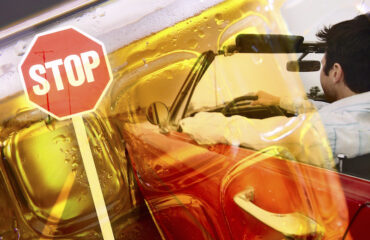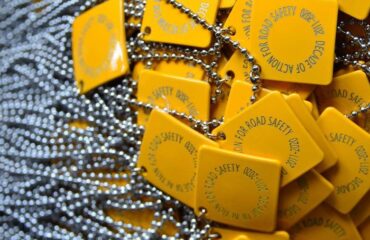20/20 vision is considered by some to be perfect eyesight, but what it really means is that a person does not need any aids, such as glasses, to see even better. There are some individuals who can see better than 20/20, but 20/20 is the goal by everyone else. Other than seeing ahead clearly, why is 20/20 vision important in traffic safety? In this situation, the term vision is being used as the idea of making plans for a future that clearly shows the way to drive safely on the road. In this post, you will find nine tips for being a safer driver.
Since it is the beginning of the year 2020, and a common time when we make New Year’s Resolutions, now is the perfect time to implement these nine tips for 20/20 safety vision. After all, many times our resolutions look to losing weight, stopping smoking, being a better friend or person. But what if we make a New Year’s resolution to be a safer driver? With traffic crashes being in the top 10 causes of death for several age groups,[1] that kind of resolution could actually save your life and the lives of your family and friends. That kind of resolution could give you 20/20 vision for safety.
Traffic Crashes and Human Error
Did you know that 94% of traffic crashes are caused by human error?[2] Whether it is a person’s inattention while driving, or driving too fast for conditions, or drowsy driving, or impaired driving, the vast majority of crashes are preventable by us being proactive and having a vision for safety. Below are nine tips on what you can do to be a safer driver.
- Put the phone down and drive. In today’s society it is a common occurrence to see someone driving while talking on a phone, or worse yet, texting. Driving by texting is as dangerous as driving with a BAC (Blood Alcohol Content) of .08. Everyone has heard of Distracted Driving, yet it is always the other person who does it. If you talk on the phone (hands free or not) you are driving distracted and putting everyone at risk of serious injuries or death. Put the phone down and focus on what is important—getting to your location safely.
- Slow it down. Almost 1/3 of all fatal crashes are estimated to be speeding-related. That means almost 1/3 of all crashes occur because someone was exceeding the speed limit or driving too fast for conditions. Speed limits are set for a reason, and they are usually based on a number of factors including road conditions, traffic patterns and the surrounding area. Around the globe it is estimated that just a 5% reduction in the average speed would reduce the number of fatal crashes by 30% not to mention it would be better for the environment. Slow it down and arrive alive.
- Wear Your Safety Belt. Wearing a safety belt can reduce the risk of death of front seat passengers by 40-65% and for rear seat passengers by as much as 75%. No matter where you are sitting in a car, always fasten your safety belt while on the road.
- Wear a good-quality helmet. If you are riding on a motorcycle, moped or similar vehicle, wearing a good-quality helmet can reduce the risk of death in a crash by 40%. In the U.S. a good-quality helmet means one that is approved by “DOT,” the Department of Transportation. Just like a safety belt in a car, a motorcyclist should always wear a helmet while on the road—whether you are a driver or a passenger.
- Don’t drive impaired. While it is common for people to say don’t drink and drive—there is now public awareness that substances other than alcohol also cause impairment. Drunk driving and drugged driving are both dangerous—for the driver and those around him or her. Whether the substance is alcohol, illegal drugs, marijuana whether “medical” or not or prescription medication, the critical process is to recognize the possibility of harm, and take action. Don’t take the risk; don’t drive impaired.
- Share the Road. If you are driving a car, you are not the only person or vehicle on the road. Depending on the time of day and the weather, you may find semi-trucks, bicyclists, motorcyclists and pedestrians all using the road. All of them have the right to do so, whether it is crossing the road at a crosswalk or cycling along side of the road. Whatever activity is being done, remember to stay focused and recognize others’ right to use the road.
- Keep your cool while driving. Human beings all get mad or frustrated about someone driving too slowly, or being cut off by another driver or being in a traffic jam because of weather or a crash. However, it is at this point that we need to take a deep breath, and ultimately, “take a chill pill.” Aggressive driving creates greater driving risks. While the trigger may be something minor, it can have immense consequences. Taking a chill pill can start before leaving home. For example, if you have to be somewhere at a specific time, try to give yourself extra time to get there. If running late is unavoidable, keep in mind it’s “better late than never.”
- Get your rest before driving. Drowsy Driving is a significant contributor to crashes. A person driving without adequate sleep is someone looking to be in a crash. Just like alcohol, sleep deprivation impairs our ability to drive safely. Being awake for 18 hours and then driving is similar to driving at a .05 BAC. The only “cure” for drowsy driving is getting enough sleep. Drinking black coffee won’t cut it. Keep in mind that sleep is a necessity, not a luxury. Adults need 7 to 9 hours of sleep a day and adolescents need 9 to 10 hours. The best strategy to avoid drowsy driving is to make your plans before starting to drive and get your rest.
- Stop on Red. How many times have you tried to “beat the red?” Did you know that the T-bone intersection crashes caused by red-light runners result in some of the most severe injuries, or that about half of the deaths in red-light running crashes are pedestrians, bicyclists and occupants in other vehicles that are hit by the red-light runners? Decide now that you will always be prepared to stop on red as a driver, cyclist, or pedestrian. When the light turns green, look in all directions for potential red-light runners before proceeding, whether driving, cycling or walking.
During this year of perfect vision, why not be proactive and have 20/20 vision for traffic safety? Everyone on the road is on a journey. Whether they are off to work, or heading home, going to visit a friend, or traveling on a new adventure, their goal is to also arrive safe and sound. By resolving to implement these nine tips, we can improve our overall safety vision and help ensure we all make it to our journey’s destination. And isn’t that the kind of resolution we can all live with?
Footnotes
[1] Motor Vehicle Traffic Crashes as a Leading Cause of Death in the United States, 2015, Traffic Safety Facts, February 2018, DOT HS 812 499.
[2] Critical Reasons for Crashes Investigated in the National Motor Vehicle Crash Causation Survey, Traffic Safety Facts, February 2015, National Highway Traffic Safety Administration, DOT HS 812 115. NOTE: This publication does not attempt to assign blame on the driver for causing the crash, it is looking at any errors by the driver.
Get more articles like this
in your inbox
Subscribe to our mailing list and get the latest information and updates to your email inbox.
Thank you for subscribing.
Something went wrong.








